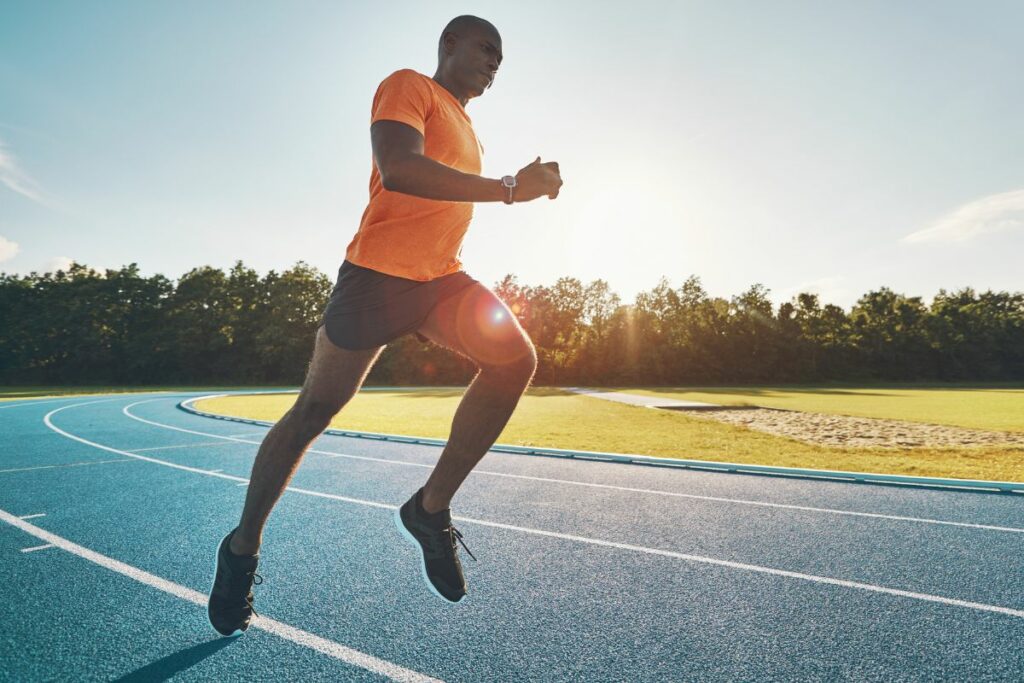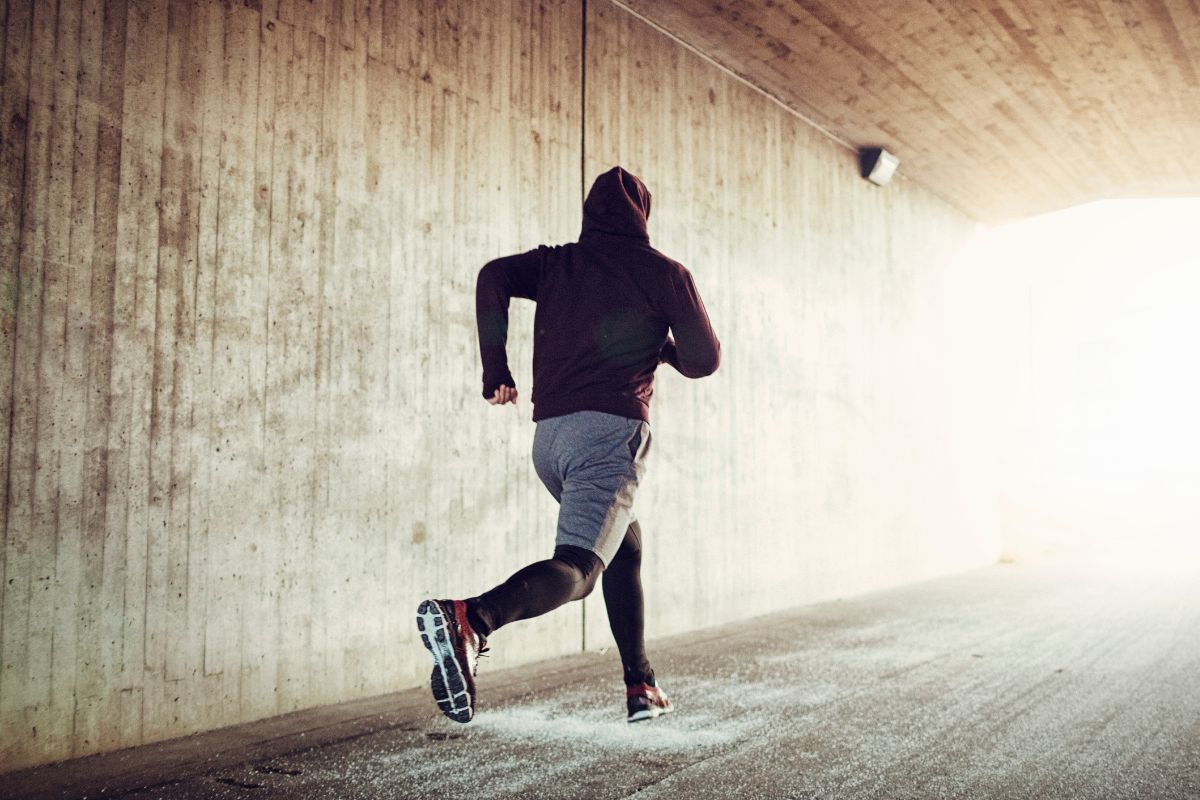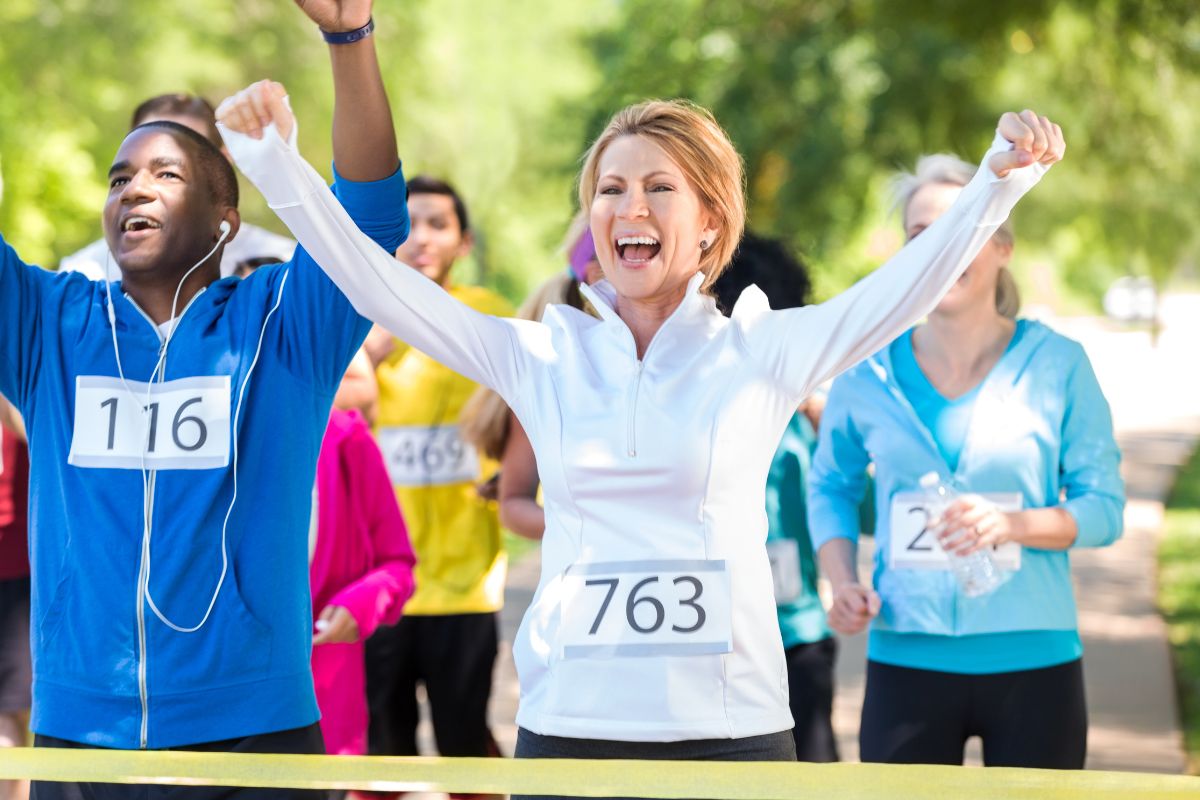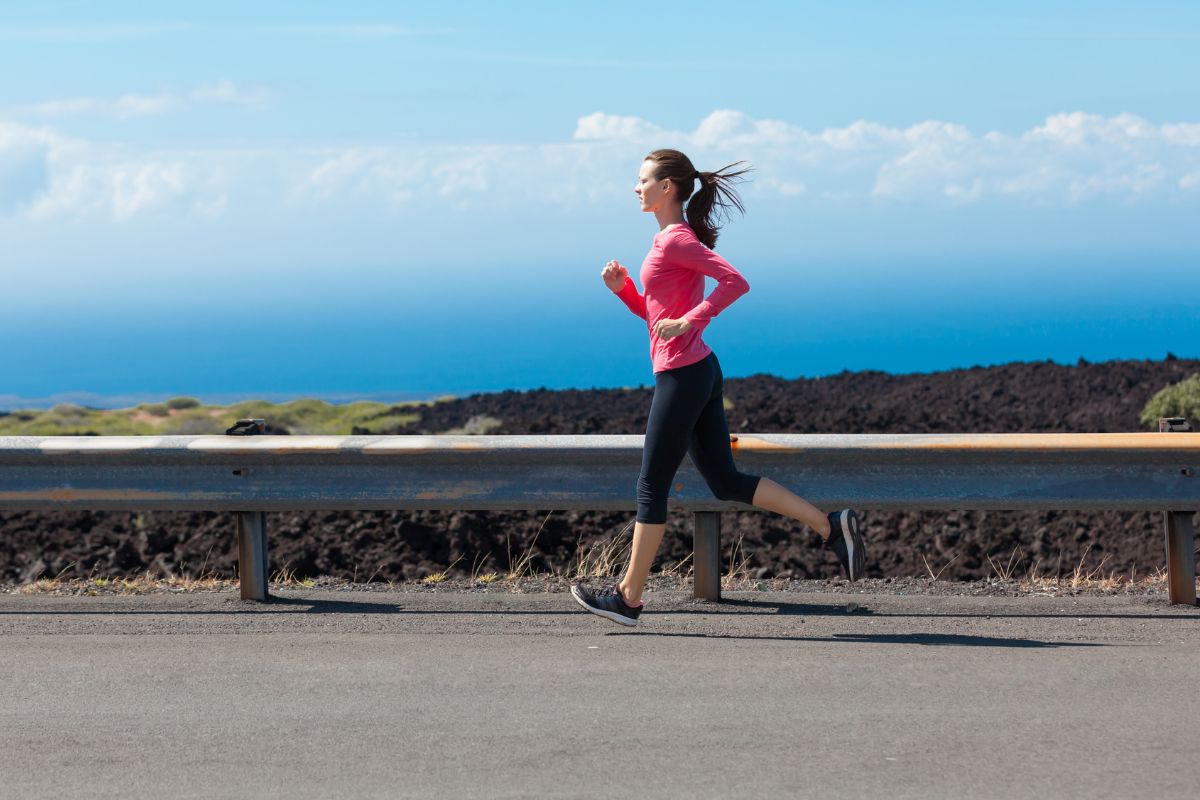As a runner, there are always goals to push towards.
Whether you’re somebody who runs casually to keep fit and stay in shape, or someone who is beginning to take it more seriously as a sport, there’s no doubt you’ll be able to find ways to improve yourself.

Some of the main facets of running are speed and endurance. If you can get mastery of these two, then you’re likely going to be able to hit the goals you want to achieve.
But how do you increase these? What are the practical tips that can help you do both at the same time?
There are a lot of technical terms in running, but one of the most important is something called running cadence.
If you’re trying to find a way to improve your cadence, then you’ve arrived at the right place!
In this article, we’re going to take you through everything you’ll need to know about understanding your cadence and improving it!
We’ve also made sure to include an extensive Frequently Asked Questions section that will help answer any questions you may have left over by the end.
So let’s lace up our shoes, learn our running cadence and improve it.
What Is Running Cadence?
Running cadence can be defined as the number of steps you take per minute.
This is one of the most fundamental things in running that will determine how fast you move and how far you’re able to travel without getting tired.
This is sometimes abbreviated to SPM. You may be wondering why we use the term ‘cadence’ as this is something usually associated with sound – but this is because cadence isn’t just the steps per minute.
Cadence is also the way your body reacts and adjusts to your running pace.
When beginners think of running, they often think of it as just something that has to do with your legs – but in reality, running is a far more holistic physical activity.
Small changes in how you move your body when running affect your cadence, and this ultimately affects your speed and efficiency. In the next section, we’re going to look at how cadence affects your performance.
The Importance Of Cadence
When you run, the more steps you take the more your form is likely to change. You can start off sessions with perfect form, but over time you’re likely to take longer strides.
Longer strides are bad for a variety of reasons, namely that they hamper your efficiency and leave you more open to injury because of the increased weight your place upon your joints and muscles.

Injuries in running usually come from impact. The more steps you take, the more impact your body is going to come into contact with.
So the worse cadence we take – as well as the more we overstride – the more chances you have to damage your body.
This is often the reason that people injure themselves just starting out, as they don’t yet know the proper form and cause too much impact to their body.
Building a better cadence when running means that you will take much shorter strides and avoid overstriding. This is going to do wonders for your speed, injury, and general body health.
The better cadence you have, the less physical load you will place upon your body.
It is often said that a proper running cadence can reduce the impact on your bones and joints by up to 20%, which means your body is less likely to injure and will be quicker to recover.
Cadence is also important for speed. Running with long strides may work for a short period of time – after all, you’re covering more ground, right?
But the problem with this is that it is unsustainable as a running style.
Maximizing your steps per minute is only going to increase the speed at which you run, as well as make sure you are efficient with your energy. Speed isn’t just about explosive muscle-twitch movement.
What Is A Good Running Cadence?
The first thing you need to know is that this will depend on who you are.
Whilst there are fundamentals that make up the good running form, everyone is different because everyone has variations in their body type.
It’s generally accepted that the standard running cadence for runners with good form is somewhere around 160-180 steps per minute.
This can vary slightly depending on your height, weight, and proportions, but if you’re somewhere within this range then you’re probably safe.
If you do already fall within this range, that’s not to say that you can’t still improve! Increasing your cadence beyond this will make you faster, more efficient, and less injury-prone.
Another thing to note about cadence, in general, is that your cadence is likely to change depending on the terrain you’re running on.
Let’s take for example a steep hill. To run safely up a stretch of ground that sharply inclines, you’ll need to shorten your stride considerably.
By leaning into them as your lift your knees, you will be less likely to hurt yourself and more efficient in your running.
But the problem is that this will massively alter your cadence, and is one of the main reasons that people find inclines so difficult.
How To Improve Your Running Cadence
So now we come to the section where we’re going to give you some practical tips on how to improve your running cadence.

We’ve broken this down into 4 main steps for you, so follow along and make sure to add these into your running routine.
Step 1. Calculating Your Cadence
You can measure your cadence in a few ways, but it’s a little more difficult of a metric to determine than some other running stats you might already be familiar with.
If you’re getting serious about running, it’s very important that you know your cadence so that you can track it as you learn and grow.
We’ve broken this process down into two main methods for you.
By Counting
Begin by warming up as you would before any run you might embark on. After this, take your time to start running and make sure that you are at your normal pace.
Set a timer for one minute on either your phone, watch, or with an app. From here, you need to begin counting in your head.
Start with the very first step and continue counting each one until the timer is up. When your timer goes off, stop counting and retain the number you ended up at.
If you’re not 100% sure that you got it right the first time, that’s okay! Simply start again and do this a few times so that you can get a number that seems right.
One thing we would like to point out is not to inflate your steps per minute by running faster than you normally would.
Run at your regular, comfortable pace.
By Use Of A Sportswatch
This can also be done with a running app on your phone, so we have lumped the two together.
Tracking your cadence digitally can be more difficult than other metrics, but modern sports tech allows you to do this.
Simply follow the steps on your watch or app, and it will most likely make you do something like our counting method above – the only difference will be that the tech will do the counting for you.
You can repeat this a few times to make sure you’re getting a similar number each go.
The good thing about using running tech to measure this is that you will be able to track the metric easier as you learn and grow.
This is something you’re going to spend some amount of time doing, so finding the best way for you to measure it is important.
Step 2. Gradually Increasing
If you’re focusing on improving your form anyway – I.E not overstriding – then you’ll notice a natural, gradual increase in your cadence.
If you’re trying to improve it consciously, then you’re also only ever going to see gradual improvement.
To improve your cadence, you have to teach your body to unlearn some bad habits and learn some new ones.
If you want to casually improve your cadence, the best thing to do is to track it from time to time.
If you find it increasing naturally, then you will know that the attention you’ve been giving to your form is helping you.
However, if you ever see a decrease then it’s important to recess. Are you overstriding? Or perhaps you’re pushing yourself to cover distances that are not comfortable for you?
Expect short increases of around 5 to 10 steps per minute.
If at the end of each week – let’s say on your last session – you make a point to track your progress, then you can see if you can meet this small goal each time you go out.
Increasing your cadence by 5 to 10 steps doesn’t seem like so much of a big deal, but if you do this week after week you’ll soon find that you’re much closer to achieving your goal.
Step 3. Metronomes
A metronome is a small, simple tool that you can use to increase your cadence. When you’re out running you’ll find yourself more receptive to sound than any other sensation.
A metronome is a small device that will make a clicking sound rhythmically. You can use this to increase your cadence and track it as much as your want to improve.
Most metronomes will have a setting that will allow you to increase or decrease the pauses before the sound clicks again.
This is perfect for running. Start by choosing a setting that best fits your current running cadence.
This might take a few minutes to work out and you might find that you’ll have to stop running and adjust it before you find the sweet spot.
Once you have a beats-per-minute that is properly in line with your running cadence, take some time to get used to it. Make sure your feets hit the ground with each beat.
After this, you can begin to play around with your metronome and increase the beats-per-minute. We would warn you away from trying to increase this too fast.
Take small steps and allow yourself to adjust to the new pace.
Generally, we would suggest adding more BPM per session, and gradually doing this until you’ve found a good pace.
Step 4. Drilling
Almost all sports involve some kind of drilling – these are small, repeatable exercises that allow you to expand your skillset.
You might be wondering how this can work for running – after all, isn’t the best way to learn good running form just to run more?
Well yes and no, there are smaller, more contained exercises that you can do in order to increase your running cadence.
One of the things about running outside for long time periods is there is a lot to think about.
First of all, is the physical exertion, but there is also other factors like trying to keep track of your energy and staying safe whilst outside.
All of this together can make keeping track of your cadence and general form very difficult.
That’s why running inside on a treadmill can be a great way to improve your cadence and focus on the more intricate aspects of running.
Use a treadmill and take great care with how you’re running. You can start on a low setting so that you can force your body to take good form.
After this, you can increase it in order to improve your cadence.
Generally, the higher the setting the more steps you’ll have to take, and the more you’ll get used to running at a higher cadence.
You can also use this inside-time as an opportunity to film yourself and access your form.
This is something that is impossible outside – unless you have somebody following you with a camera – so it is a unique opportunity to get a third-person look at yourself.
Take a good look at your form – are you overstriding? Is your upper body moving with the rest of you? Considering these thoughts can be vital to improving your overall cadence and performance.
Frequently Asked Questions
Should You Run With Shorter Or Longer Strides?
It is almost always better to run with shorter strides. This is one of the main things that affects cadence and could be the difference between injuring yourself and staying safe.
Shorter strides will decrease the overall impact of each step, reinforce good footfall, and help you to maintain proper body positioning.
What Are The Main Running Injuries?
Some of the most common running injuries are medial tibial stress syndrome, plantar fasciitis, and Achilles tendinopathy.
Another thing that many new runners will come across is ankle sprains.
This last one can be avoided by proper running form and good footwear. Pushing yourself is an easy way to take the wrong step and roll your ankle!
How Long Will It Take Me To Run 5k?
A 5k run is one of the first goals that many beginner runners look towards.
A 5k run will take an average runner around 40 minutes to complete, though this varies drastically depending on your competency level.
A 5k run is close to 3.1 miles in distance, so it’s quite a good distance if you’re just starting out.
If you’re wondering how long it will take you to build up to running 5k, this can vary depending on how your general fitness levels, your running experience, and how well you learn new things.
That said, it will likely take a beginner between 1 and 3 months to build up to be able to run this distance.
The most important thing here is that you take your time – goals take much longer if you go overboard and injure yourself!
Is Any Cadence Too High For Running?
Increasing your running cadence above 120 SPM is a difficult thing that not many runners achieve, however you may be wondering what happens if you extend it beyond this.
Generally, a higher cadence is always better, with some of the top numbers humans are capable of being beyond 200 SPM.
Some of the fastest long-distance runners in the world will cap out at around this number.
What Is A Good Posture For A Good Cadence?
The best posture for running includes a straight back with level shoulders.
Your head should be up and you should have a neutral core.
Running actually has more to do with your core than you might think, and properly supporting the rest of your body with a good center is a great way to do this.
Make sure that you don’t either lean too far forwarder back. All of this is especially important when you begin to tire, as this is the time when form can start to go out of the window.
Maintaining good form is one of the most important things that will increase your cadence and endurance. Starting to maintain this early is very important and means that you won’t have to correct yourself later in your running journey.
Generally, a high cadence + good form is going to give you all the skills you need to be a great runner!
Final Thoughts
So there you have it! Those were the 4 main steps that you can take to improve your running cadence.
If you’re beginning to think about cadence, it’s likely you’re taking the right steps towards improving your overall running performance.
It’s one of the many facets of running that will help you improve and achieve whatever goal it is that you set for yourself.
We would like to point out here that cadence is not something you can magically improve – it takes time, dedication, and a lot of self-correction to get right.
That said, it is something that will improve over time and within a year or two, you’re likely to find yourself where you need to be.
We hope that this article has given you all the information you wanted to know about running cadence and that you now have some strategies to use going forward.
If you still have some more general questions about running or running cadence, check out our short FAQ section below!
We wish you the best of luck on your journey and hope that you reach any goal you’ve set for yourself – no matter what it is!
- Can Dogs Run Faster Than Humans? (Running With Your Furry Friend) - October 4, 2022
- 10 Doggie Fun Runs You Will Love [Ultimate Guide] - October 4, 2022
- What Are Division Results In Running? - October 4, 2022








